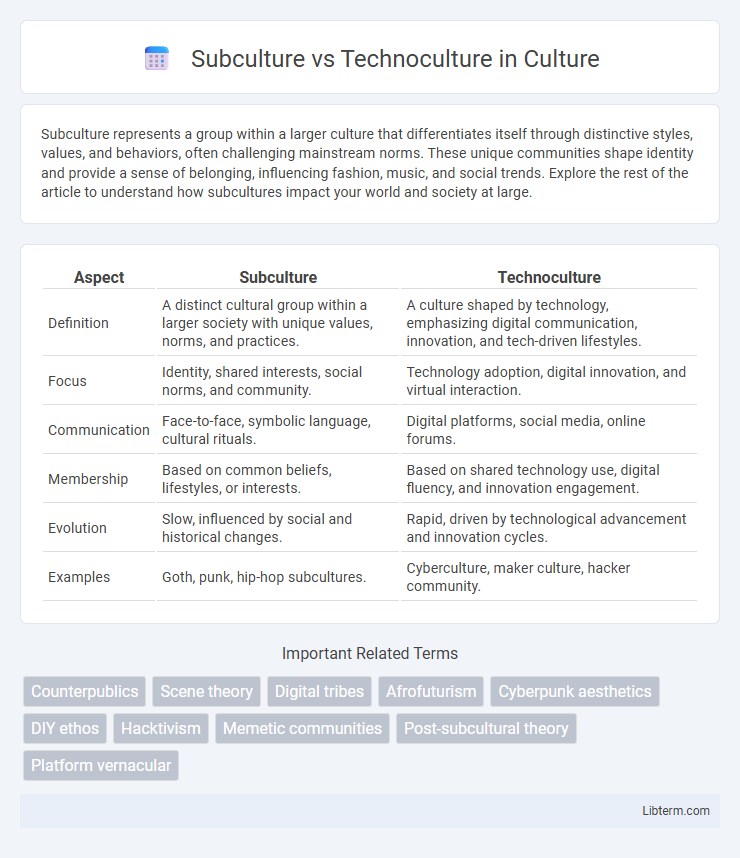Subculture represents a group within a larger culture that differentiates itself through distinctive styles, values, and behaviors, often challenging mainstream norms. These unique communities shape identity and provide a sense of belonging, influencing fashion, music, and social trends. Explore the rest of the article to understand how subcultures impact your world and society at large.
Table of Comparison
| Aspect | Subculture | Technoculture |
|---|---|---|
| Definition | A distinct cultural group within a larger society with unique values, norms, and practices. | A culture shaped by technology, emphasizing digital communication, innovation, and tech-driven lifestyles. |
| Focus | Identity, shared interests, social norms, and community. | Technology adoption, digital innovation, and virtual interaction. |
| Communication | Face-to-face, symbolic language, cultural rituals. | Digital platforms, social media, online forums. |
| Membership | Based on common beliefs, lifestyles, or interests. | Based on shared technology use, digital fluency, and innovation engagement. |
| Evolution | Slow, influenced by social and historical changes. | Rapid, driven by technological advancement and innovation cycles. |
| Examples | Goth, punk, hip-hop subcultures. | Cyberculture, maker culture, hacker community. |
Defining Subculture: Meaning and Origins
Subculture refers to a distinct group within a larger culture that shares unique values, norms, and symbols, often emerging as a response to mainstream societal influences. Originating from sociological studies in the mid-20th century, subcultures express identity through specific styles, language, and behaviors that differentiate members from dominant cultural groups. This concept highlights the dynamic nature of social groups, emphasizing resistance, creativity, and alternative lifestyles as core elements of subcultural formation.
Technoculture Explained: A Modern Phenomenon
Technoculture represents the integration of digital technology and cultural practices, shaping how societies communicate, create, and consume information in the digital age. This modern phenomenon emphasizes the influence of the internet, social media, and emerging technologies on identity formation, social interaction, and cultural expression. As a dynamic force, technoculture continuously evolves, reflecting advancements in artificial intelligence, virtual reality, and global connectivity.
Historical Evolution of Subculture
Subculture emerged during the early 20th century as distinct groups formed around shared values, styles, and resistance to mainstream norms, often influenced by industrialization and urbanization. These groups developed unique symbols, language, and practices that fostered identity and community, such as the Beat Generation in the 1950s or punk culture in the 1970s. Over time, subcultures evolved by integrating technology, but maintained distinct cultural expressions separate from the technoculture's focus on digital innovation and technological integration.
The Rise of Technoculture in the Digital Age
The rise of technoculture in the digital age is characterized by the pervasive integration of technology into everyday life, reshaping communication, entertainment, and social interactions through digital platforms and virtual environments. Unlike traditional subcultures rooted in physical communities, technoculture thrives on technological innovation, cybernetics, and the global connectivity of the internet, fostering new forms of identity and cultural expression. This shift emphasizes data-driven experiences, augmented reality, and social media ecosystems, highlighting the transformative impact of digital technology on cultural practices and social norms.
Key Characteristics of Subcultures
Subcultures are defined by distinct values, norms, and practices that differentiate a group from the mainstream culture, often centered around shared interests like music, fashion, or lifestyle. Key characteristics include a strong sense of identity, use of symbolic language or style, and resistance to dominant cultural norms. These elements foster community cohesion and provide members with alternative ways of expressing individuality and social belonging.
Core Elements of Technoculture
Technoculture centers on the integration of technology with cultural practices, emphasizing digital communication, cybernetic systems, and virtual environments. Core elements include the pervasive use of information technology, the formation of online communities, and the shaping of identity through digital media. This contrasts with subculture, which primarily revolves around shared values, norms, and styles within a distinct social group rather than technology-driven interaction.
Social Impact: Subculture vs. Technoculture
Subcultures create distinct social identities and foster community through shared values, styles, and practices that often resist mainstream norms, impacting social cohesion and cultural diversity. Technoculture, driven by digital advancements and technology adoption, reshapes social interactions, communication patterns, and access to information on a global scale. The interplay between subculture and technoculture influences how individuals form connections, express identity, and engage with societal changes in an increasingly digitalized world.
Intersections: Where Subculture Meets Technology
Subculture and technoculture intersect where digital platforms enable niche communities to thrive and innovate, blending traditional social identities with emerging technologies. Online forums, gaming environments, and social media serve as hubs for subcultural expression, allowing members to co-create shared languages, aesthetics, and values through technological tools. This fusion accelerates cultural evolution, as technology shapes subcultural practices and subcultures influence technological development.
Influence on Identity and Community Formation
Subcultures shape identity through shared symbols, values, and practices that often resist mainstream norms, fostering tight-knit communities with distinct social dynamics. Technoculture redefines identity by integrating digital technologies, creating virtual communities where interactions transcend geographical boundaries and blur traditional social distinctions. Both influence community formation by offering alternative spaces for self-expression and collective belonging, yet technoculture emphasizes connectivity and fluid identities enabled by digital networks.
Future Trends: The Blend of Subculture and Technoculture
Future trends indicate a growing fusion between subculture and technoculture, driven by digital innovation and social media platforms that enable niche communities to thrive globally. Virtual reality, augmented reality, and blockchain technologies contribute to new forms of identity expression and communal experiences within subcultures. This blending enhances cultural diversity and transforms traditional subcultural practices into dynamic, interactive digital phenomena.
Subculture Infographic

 libterm.com
libterm.com